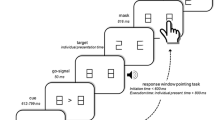Abstract
Humans demonstrate motor learning when exposed to changes in the dynamics of movement or changes in the visuomotor map. However, when two opposing dynamic transformations are learned in succession, the memory of the first is overwritten by learning of the second; the same is true for two opposing visuomotor rotations. This retrograde interference is not seen for all combinations of transformations, however. When a dynamic transformation is learned subsequent to a visuomotor rotation, the presence or absence of interference appears to depend crucially on the structure of the dynamic task: a force-field dependent on the position of the hand produces interference, whereas an inertial load applied lateral to the hand does not. To explain these results, it has been hypothesized that two transformations can be learned without interference if they depend on two different kinematic parameters of movement (such as position and velocity of the hand). Here we demonstrate, contrary to this hypothesis, interference between a dynamic transformation that depends on the position of the hand and one that depends on its velocity. However, the interference was found to be incomplete, supporting the view that the ability to retain motor memories for different tasks depends on the degree to which their representations conflict in working memory.


Similar content being viewed by others
References
Baddeley A (1986) Working memory. Clarendon, Oxford
Baddeley A (1992) Working memory. Science 255:556–559
Baraduc P, Wolpert DM (2002) Adaptation to a visuomotor shift depends on the starting posture. J Neurophysiol 88:973–981
Bock O (2003) Sensorimotor adaptation to visual distortions with different kinematic coupling. Exp Brain Res 151:557–560
Bock O, Schneider S, Bloomberg J (2001) Conditions for interference versus facilitation during sequential sensorimotor adaptation. Exp Brain Res 138:359–365
Brashers-Krug T, Shadmehr R, Bizzi E (1996) Consolidation in human motor memory. Nature 382:252–255
Caithness G, Osu R, Bays P, Chase H, Klassen J, Kawato M, Wolpert DM, Flanagan JR (2004) Failure to consolidate the consolidation theory of learning for sensorimotor adaptation tasks. J Neurosci 24:8662–8671
Cheney PD, Preston JB (1976) Classification of fusimotor fibers in the primate. J Neurophysiol 39:9–19
Flash T, Hogan N (1985) The coordination of arm movements: an experimentally confirmed mathematical model. J Neurosci 5:1688–1703
Gandolfo F, Mussa-Ivaldi F, Bizzi E (1996) Motor learning by field approximation. Proc Natl Acad Sci Usa 93:3843–3846
Goodbody SJ, Wolpert DM (1998) Temporal and amplitude generalization in motor learning. J Neurophysiol 79:1825–1838
Imamizu H, Uno Y, Kawato M (1995) Internal representations of the motor apparatus: implications from generalization in visuomotor learning. J Exp Psychol Hum Percept Perform 21:1174–1198
Johnson MT, Ebner TJ (2000) Processing of multiple kinematic signals in the cerebellum and motor cortices. Brain Res Brain Res Rev 33:155–168
Krakauer JW, Ghilardi MF, Ghez C (1999) Independent learning of internal models for kinematic and dynamic control of reaching. Nat Neurosci 2:1026–1031
Krakauer JW, Pine ZM, Ghilardi MF, Ghez C (2000) Learning of visuomotor transformations for vectorial planning of reaching trajectories. J Neurosci 20:8916–8924
Sainburg RL, Ghez C, Kalakanis D (1999) Intersegmental dynamics are controlled by sequential anticipatory, error correction, and postural mechanisms. J Neurophysiol 81:1045–1056
Shadmehr R, Mussa-Ivaldi F (1994) Adaptive representation of dynamics during learning of a motor task. J Neurosci 14:3208–3224
Tong C, Wolpert DM, Flanagan JR (2002) Kinematics and dynamics are not represented independently in motor working memory: evidence from an interference study. J Neurosci 22:1108–1113
Wigmore V, Tong C, Flanagan JR (2002) Visuomotor rotations of varying size and direction compete for a single internal model in motor working memory. J Exp Psychol Hum Percept Perform 28:447–457
Author information
Authors and Affiliations
Corresponding author
Rights and permissions
About this article
Cite this article
Bays, P.M., Flanagan, J.R. & Wolpert, D.M. Interference between velocity-dependent and position-dependent force-fields indicates that tasks depending on different kinematic parameters compete for motor working memory. Exp Brain Res 163, 400–405 (2005). https://doi.org/10.1007/s00221-005-2299-5
Received:
Accepted:
Published:
Issue Date:
DOI: https://doi.org/10.1007/s00221-005-2299-5




